ISSN ONLINE(2319-8753)PRINT(2347-6710)
ISSN ONLINE(2319-8753)PRINT(2347-6710)
K.M. Jagadale 1, Prof V. R. Gambhire2
|
| Related article at Pubmed, Scholar Google |
Visit for more related articles at International Journal of Innovative Research in Science, Engineering and Technology
This paper discusses concept of Quasi turbine (QT) engines and its application in industrial systems and new technologies which are improving their performance. The primary advantages of air engine use come from applications where current technologies are either not appropriate or cannot be scaled down in size, rather there are not such type of systems developed yet. One of the most important things is waste energy recovery in industrial field. As the natural resources are going to exhaust, energy recovery has great importance. This paper represents a quasi turbine rotary air engine having low rpm and works on low pressure and recovers waste energy may be in the form of any gas or steam. The quasi turbine machine is a pressure driven, continuous torque and having symmetrically deformable rotor. This report also focuses on its applications in industrial systems, its multi fuel mode. In this paper different alternative methods discussed to recover waste energy. The quasi turbine rotary air engine is designed and developed through this project work
Keywords |
| Quasi turbine (QT), Positive displacement rotor, piston less Rotary Machine. |
I. INTRODUCTION |
| A heat engine is required to convert the recovered heat energy into mechanical energy. Heat engines generally require compression and expansion of a working fluid. The Quasi turbine is the most compact and efficient tool currently available for compression and expansion of most working fluids. Therefore, the Quasi turbine will be used for all examples involving use of heat engines for converting recovered heat energy into mechanical energy. The Quasi turbine is a positive displacement turbine alternative, suitable as a double-circuits rotary motor or expander for compressed air, steam and other fluids. The Quasi turbine is a compact, low weight and high torque machine with top efficiency. |
| The Quasi turbine is a piston less Rotary Machine using a deformable rotor whose vanes are hinged at the vertices. The volume enclosed between the vanes of the rotor and the stator casing provides compression and expansion in a fashion similar to the familiar Wankel engine, but the hinging at the edges allows higher compression ratio. |
II. LITERATURE REVIEW |
| Carol Cro [1], [2] in his paper explained that the Quasi turbine is a rotary engine which is much different than the Wankel and other similar rotary engines. since the Quasi turbine can be configured as either a pneumatic or steam engine, there is the possibility of combine a Quasi turbine I.C. engine with a pneumatic or steam Quasi turbine to harvest the energy from the high temperature exhaust gases further made research and explained how the heat is recovered from the engine exhaust with the help of Quasi turbine air engine. He also explained the concept of binary Quasi turbine. Mr. Myron D. Stokes [3] have presented the study of Quasi turbine technology used in a vehicle propulsion system, it can be used instead of IC engine. The concept of Quasi turbine rotary air engine was first introduced by Gilles Saint-Hilaire and etal, [4]. He says that the Quasi turbine turbo-machine is a pressure driven, continuous torque and symmetrically deformable spinning wheel. He presented that with the help of Quasi turbine air engine even at low rpm high torque can be obtained. G.M. (Chemist), [5] have evaluated that the Quasi turbine is used as the alternative for power generation strategies. The engine‘s primary application is intended to be one where a combustible, gaseous fuel is readily available and where waste heat can be profitably used to increase overall efficiency. Michael R. Muller, [6] have evaluated, how the Quasi turbine is used as the Steam Engine. Mr. George Marchetti [7] Mr. George Marchetti is vice-chairman of the Chicago Chapter of the Electrochemical Society, and he did quite an extensive analysis of the Quasi turbine technology. |
III. BASIC THEORY OF THE QUASI TURBINE AIR ENGINE |
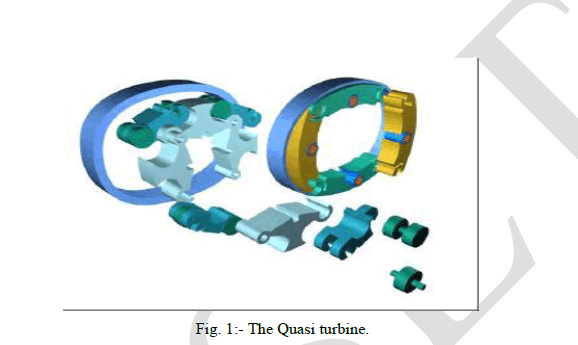 |
| The Quasi turbine is a pressure driven continuous torque deformable spinning wheel.[5] Above figures 1 shows the rotor and casing elements. It can be considered to be the crossroad of three modern engines – Inspired by the turbine, it perfects the piston and improves upon the Wankel. A Quasi turbine is thus a non-crankshaft rotary engine having a four faced articulated rotor with free and accessible center, rotating without vibration and producing high torque at low RPM. The rotor as an assembly is deformable and the four faces are joined together by hinges at the vertices. The volume enclosed between the blades of the rotor and stator casing provides compression and expansion in a fashion similar to the Wankel engine. |
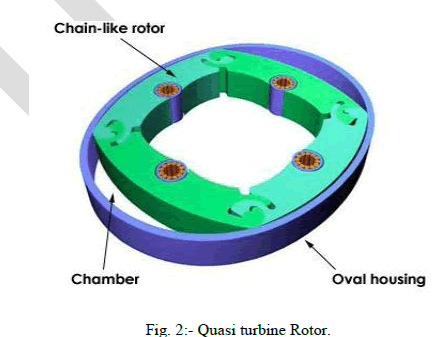 |
| This model was designed for compressed air and steam applications. The Quasi turbine can handle large volumes of air or steam. Below figure shows the rotor in the top dead center position. The rotor consists of four blades which are identical. Each of the four blades produces two compression strokes per revolution which provides a total of eight compression strokes per revolution when used as a compressor. When used as an air or steam, eight power strokes per revolution are provided. The model has four ports; starting with the upper right port we will number the ports clockwise 1234. Ports 1 and 3 are intake ports and ports 2 and 4 are exhaust ports. For one complete rotation of the rotor, the total displacement is eight times the displacement of a one of the chambers. |
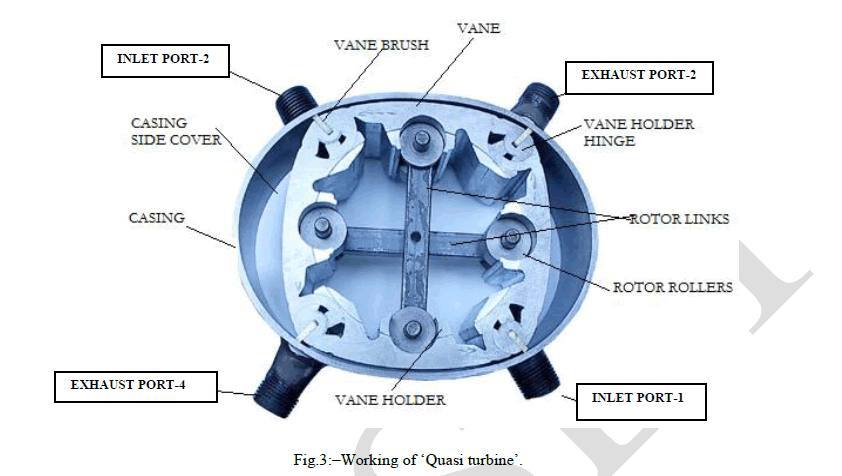 |
| The âÃâ¬ÃâQuasi turbine‘ is a piston less Rotary Machine using vanes which are hinged at the ends. The volume enclosed between the vanes and casing provides compression and expansion. The hinging at the edges allows higher compression ratio. The two inlet pressure of compressed air rotates vanes in opposite direction this equal and opposite forces forms a couple and moves the vanes thus shaft of turbine rotates. âÃâ¬ÃâQuasi turbine‘ is a compact, low weight and high torque machine with high efficiency. The âÃâ¬ÃâQuasi turbine‘ rotates from pressure as low as 1 bar. It has higher power to weight ratios and mechanical simplicity. |
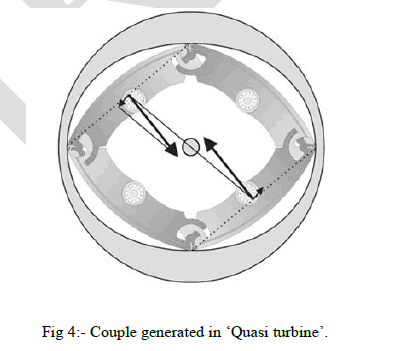 |
| Above figure no.4 show the force vector in a âÃâ¬ÃâQuasi turbine‘ when two opposed chambers are pressurized, by external compressed air. Because the pressure vectors are off center, the âÃâ¬ÃâQuasi turbine‘ rotor experiences a net rotational force. The whole construction of âÃâ¬ÃâQuasi turbine‘ is shown in the following figure. It consists of vane, vane holders, rotor link bracket, sun & planet gears, and bearings, casing and casing plate etc. |
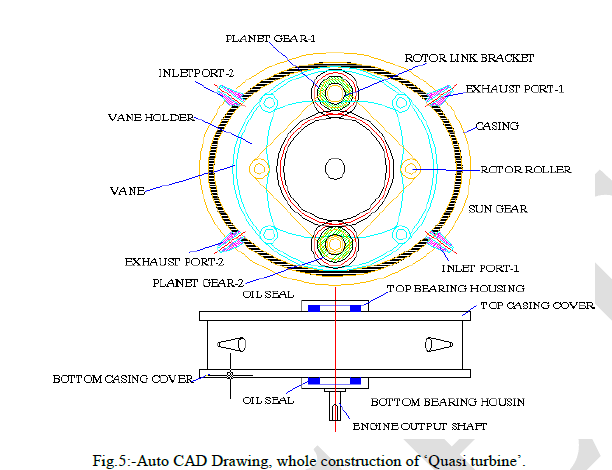 |
| In the gas turbine, the combusted gases are directed through nozzles against the blade of the turbine rotor and are expanded to atmospheric pressure. The amount of work derived from the gas turbine engine is the difference between the work required to compress the air and the work obtained from the turbine. In the Quasi turbine, there are no turbine blades. Instead, the high pressure of the gases during the power stroke forces each rotor segment in the direction of rotation (static pressure expansion). Thus, the Quasi turbine is a static pressure engine, not an aerodynamic, constant pressure engine. |
| In Quasi turbine air engine, an oval housing surrounds a four-sided articulated rotor which turns and moves within the housing, trapping the working fluid (air) into four chambers. As the rotor turns, its motion and the shape of the housing cause each side of the housing to get closer and farther from the rotor, compressing and expanding the chambers similarly to the "strokes" in a reciprocating engine. By selectively admitting and discharging air, the four chambers of the rotor generate eight power "strokes" per rotor revolution which results in smooth operation at a large range of rotation. |
| Binary Quasi turbine: The Brayton cycle requires at least two Quasi turbine - one for the compressor and one for the prime mover, with different displacements. The two different Quasi turbine could be cascaded together on the same shaft to satisfy the requirement. Cascading of two Quasi turbine on the same shaft would not be not difficult, but a more cost effective and compact unit of two Quasi turbine could be designed which would integrate two independent Quasi turbine into a single package. This integrated package of two independent Quasi turbine will be called a binary Quasi turbine |
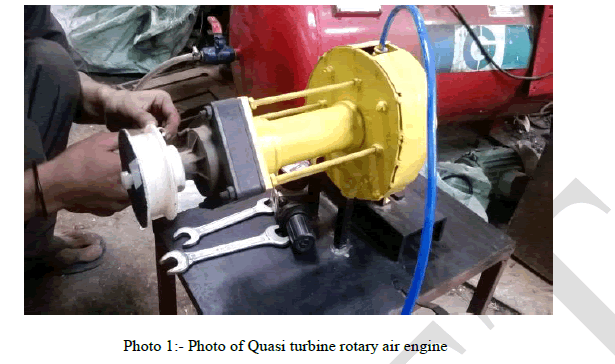 |
| Photo 1 is showing the actual view of quasi turbine rotary air engine. On this model the tests are taken and results, conclusions are drawn. The above model is designed and manufactured in workshop with the help of different machines and manufacturing processes. Epicycle gear train is used for speed reduction from turbine to output shaft. Shaft of quasi turbine is extended to one side to reduce the forces on the rotor of the turbine. |
IV. TEST & TRIAL ON QUASI TURBINE AIR ENGINE |
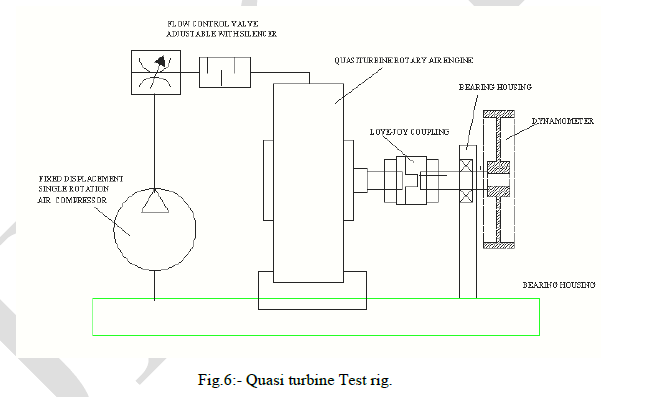 |
| Trial is to be conducted on Quasi turbine air engine to determine |
| Torque Vs Speed Characteristics |
| Power Vs Speed Characteristics |
| In order to conduct a trial, rope brake dynamo meter, pulley, cord, weight pan are provided on the output shaft. |
| Procedure:- |
| 1. Start air supply by turning valve knob. |
| 2. Note down pressure reading (bar) |
| 3. Note down air flow in (l.p.m.) |
| 4. Let equipment run & stabilize at certain speed |
| 5. Place the pulley cord on rope brake dynamo meter pulley and add 100 gm weight into, the pan, note down the output speed for this load by means of tachometer. |
| 6. Add another 100 gm weight & take reading. |
| 7. Tabulate the readings in the observation table |
| 8. Plot Torque Vs speed characteristic, Power Vs speed characteristic, Power Vs Air Intake (Consumption). |
V. EXPERIMENTAL RESULTS |
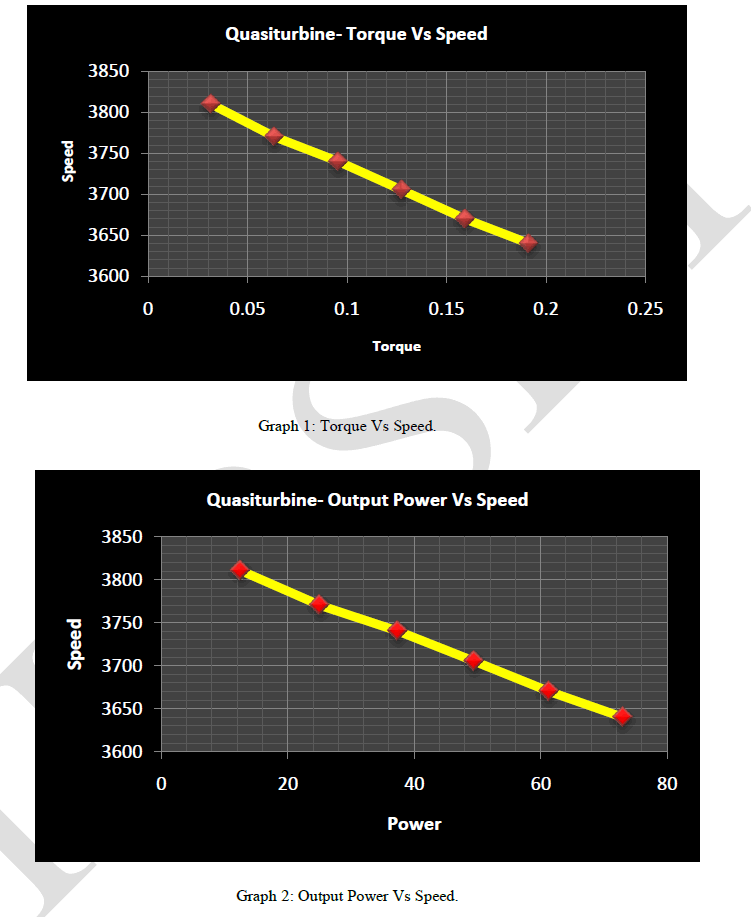 |
| Above graphs is showing performance of quasi turbine rotary air engine, graph 1 shows that at higher speeds the torque output is less and at lower speeds torque output is high. Graph 2 shows that at high speeds power output is less. |
| Applications- |
| Waste air pressure recovery in blow moulding process:- Now days the blow molding process is widely used because of universal use of packaged foods like mineral water, cold drinks beverages etc. At the time of blow molding the air is used at 30-40 bar pressure. After use of that air, it is escaped to atm. So the pressure energy with that air is wasted. That wasted energy is recovered by the use of quasi turbine rotary air engine. Quasi turbine will work as a good energy recovering instrument by recovering pressure energy wasted in the blow molding process. . |
| Gas Pipeline Pressure Energy is recovered.[4],[11]:- âÃâ¬ÃâQuasi turbine‘ is to recover the pipeline high pressure energy at local distribution stations, instead of using a conventional pressure regulator. It is used as a Steam Engine. [10] :- Solar, geothermal, biomass, cogeneration and heat recovery are natural applications for the Quasi turbine steam engine due to its simplicity, low price and low maintenance cost. Engine exhaust heat energy is recovered by quasi turbine rotary air engine. [1], [2]:- |
| Conversion of solar energy to electrical energy. [2], [4] :- The solar concentrator collects solar energy which is focused on a heat exchanger to heat water. Steam is released into the Quasi turbine and expansion takes place, the pressure is reduced and the steam escapes out. Generator is coupled to Quasi turbine air engine which produces electrical energy. Industrial application:- It is used for the industrial application like in drilling machine, die grinders, run the pumps, compressor. |
| Other Applications. [2] :- It is most appropriate for zero vibration hand tools, chainsaws, etc. The Quasi turbine is highly suitable as air compressor and water pump, hydraulic pump and motor, turbo-pump etc. as well. |
VI. CONCLUSION |
| The Quasi turbine is thus a pressure driven engine producing continuous torque with a symmetrically deformable spinning wheel. The basic limitation of the Quasi turbine engine at a present stage is that it is in its infancy stage. Though a lot of advancements has been made since its invention has been marked. Quasi turbine is a new technology probably unwelcome in the world of engine establishment. Quasi turbine machine having very reliable technology and the model is having maximum efficiency 62% at 3640 rpm. It is very clean, low weight, low rpm energy recovering instrument. |
ACKNOWLEDGMENT |
| The authors wish to acknowledge the support rendered by Tatyasaheb Kore Institute of Engineering and Technology, Warnanagar in preparation of this manuscript. |
References |
|